A Brush with Life - Issue #68 What a Woman Can Do and other Truths
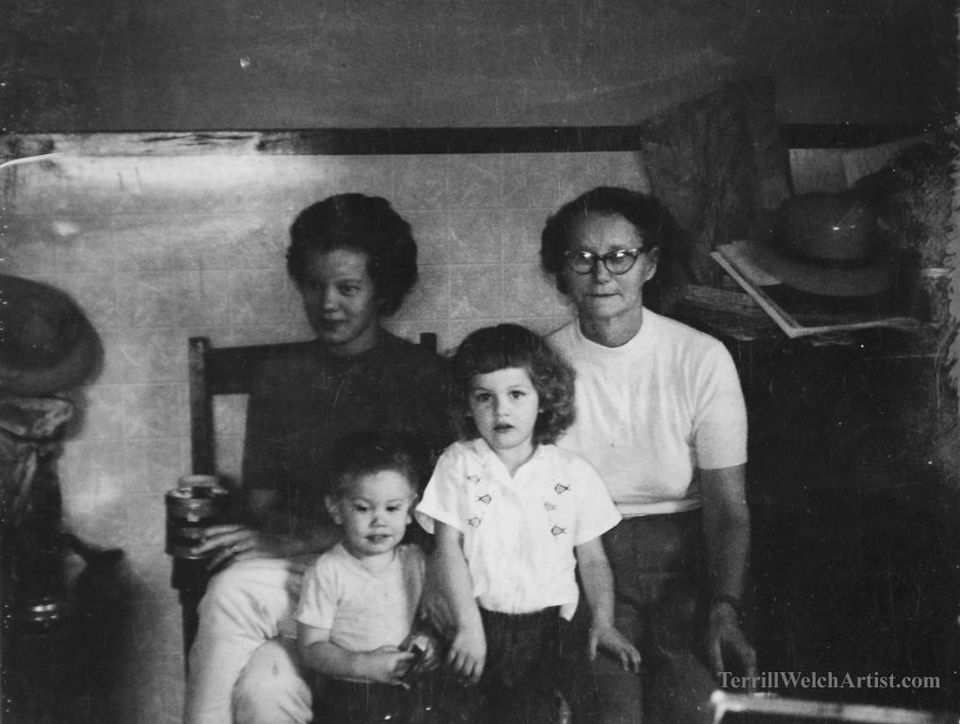
I promised you a special holiday issue today and we are hopeful that this offering meets with your expectations. Since it is the holidays, and the very day of December 25, 2020, all the other gallery artists are home with their immediate households. So there is not much of a “we” today as I pull up my chair to tell you a story or three. As is my own childhood tradition, when one invites others or goes visiting, it is never without a few stories to tell. They can be new stories or old favourites. Whichever it is, what is most important is to have them at the ready.... This is a time in rural north central British Columbia with no internet, no television and the batteries for the radio are saved to listen to the daily news. Newspapers are rare and usually weekly or monthly additions. Because there are no telephones, message are sent over the radio for funeral notices and doctors or dentist appointments or to pick up grandchildren or Uncle Joe from the nearest town. It is in this context we venture back and forth through time in our storytelling in no particular order or geographic location. So take your boots off at the door, pad softly in your home knit wool socks to your chair at the kitchen table. You will find it just in front of this photo of my mother Nell, brother Jack, me and my grandmother Mona who is my maternal grandmother.

There is a wood cook stove just behind you to left with one of my teenage uncles sitting on the top of the water reservoir and my grandfather is across the narrow passage from the stove in his chair beside my mother. The chair now lives at my house and has been recovered and the old wood oiled. I can still see him in my mind’s eye sitting there turning his hearing aid down because the conversations are getting too loud and jumbled for him to hear properly. He could read lips reasonably well and most times just nodded and smiled and sometimes getting up and going to get his fiddle and would play for us kids (and anyone else that wanted to listen) in the next room.
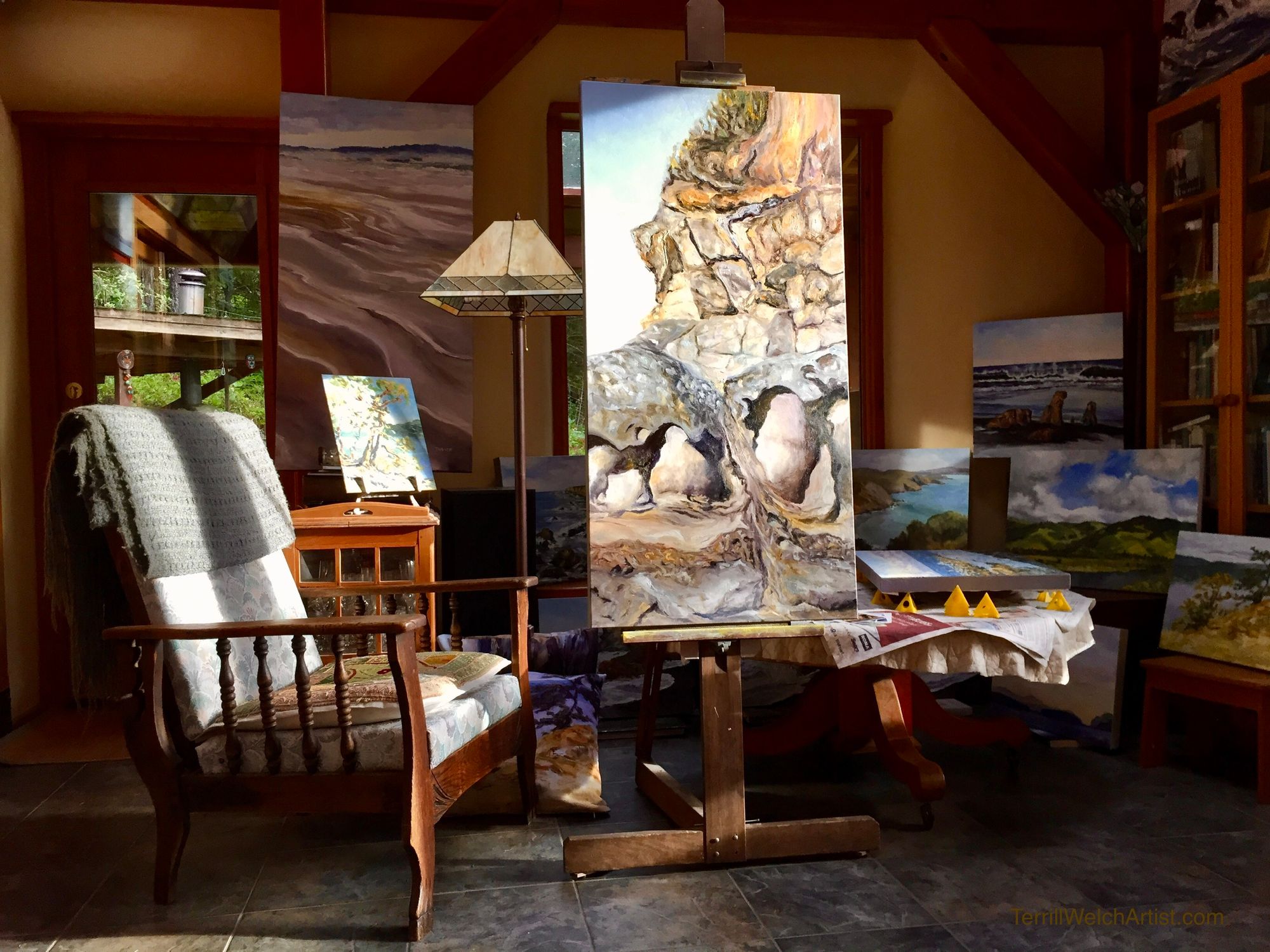
The water buckets by the door and creamer have been filled, from a hole in the ice on the river, along with the wood box before it got dark and the gas lamps have to be lit. If it was Christmas time, more people would be arriving and the wood stove in the living room would be going as well to keep out the winter cold. With the rooms bursting with aunts, uncles, cousins, second cousins, in-laws, out-laws and the greats of all sorts, cloudy with cigarette smoke and wood smoke, there was the added unmistakable smell of drying furs caught on my grandfather’s trap line, pan-fried moose steak from supper that would be mingling with the sweet buttery aroma of shortbread on the table for evening coffee. It is now time to tell a story. There is no order or announcement to these story exchanges and they are punctuated by jokes and squabbling siblings and often the clatter of dishes being washed and dried and put away. This is just what happened, 40 km outside of Vanderhoof at the Stuart River, after sliding down the steep hill and hopefully making the turn into my grandparent’s gate. So let’s start there with my first story on one holiday season when my mother probably was about the same age as I am in the photo above...
Going to Get Her First Tree
This rather blurry photograph below, I believe, was taken sometime around 1941. The location is not in question as it is along the Stuart River on my grandparent's homestead. It is the year I am not absolutely sure about.
My aunt told me “The horse's name was Old Heart because of the shape of the white patch on her forehead. ( probably just Heart but she was always Old Heart to us).”
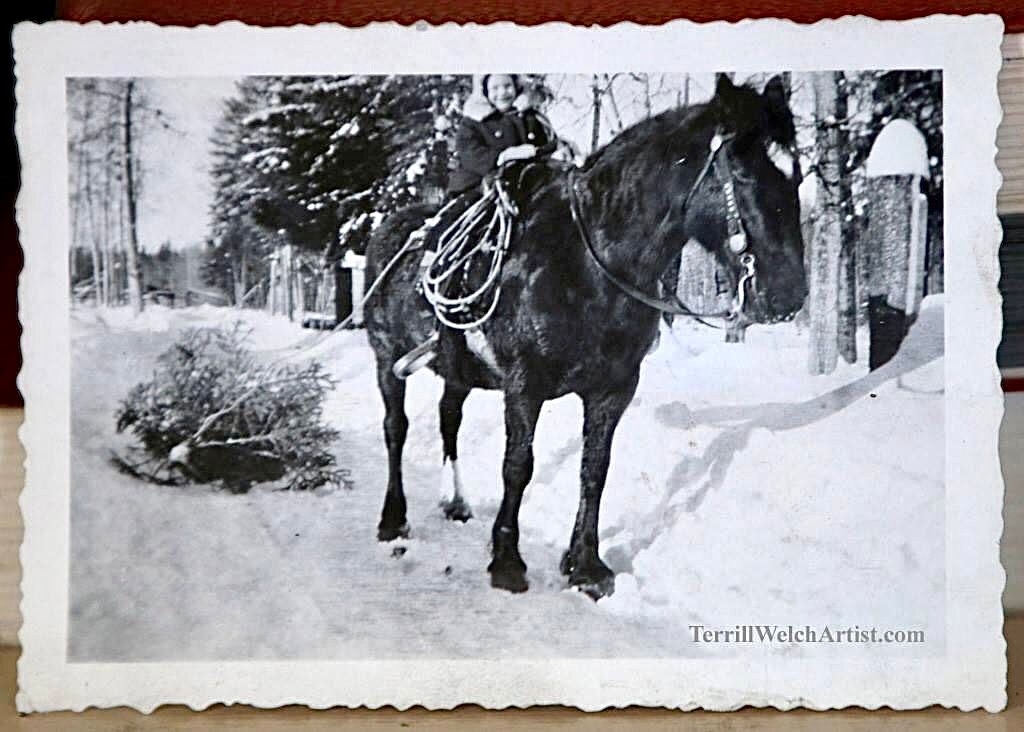
There was no car on this rural farm at this time. All travel, when travel was necessary, was done on foot, horseback or horse and wagon. On this particular December day, a little girl, by herself, went to get the Christmas Tree with her favourite horse. She is likely about five years old I think, though it is hard to tell in photograph, and it has been a long time since I have been told this story. When I looked at this photograph as a child myself, I didn't wonder how this small girl, who is my mother Nell, got up and down off the horse because I knew.
My grandmother had told me many times the secret to this obstacle. The little girl would ask the horse to lower her head, sometimes sweetening the offer with a choice handful of grass or hay. When the horse dropped her head, the girl would climb on the horse's neck and the horse would raise her head. Then the girl would shimmy around onto the back of the horse. Easy as that! These two had been doing this trick since the girl was old enough to toddle out into the yard and through the fence to where the horse was grazing.
I also know that the little girl was in the trusted care of the horse for this adventure! Her parents and the child herself knew that she was perfectly safe to go out to the back 40 acres, cut down a tree, tie it up with a rope to the saddle horn and drag it back to the house because the horse would look after her. They were a team this special little girl and that equally special horse and mighty pleased with themselves too!
I am pretty sure my grandmother took this photograph. I am very glad that she did because without such evidence it may be hard to believe.
My mother is still living out along the Stuart River with my father and only gets online infrequently when she comes into town and goes to the public library. During COVID times, not even that is possible. They are now in their early 80’s, still have 40 head or so of cattle to look after, only wood heat, propane cook stove, fridge, hot water tank and lights. There is no electricity or cell coverage. Right now, they have a satellite phone that is wonky and cuts out all the time and this will be the case until the landline can be restored possibly next summer. There are a few solar lights and a generator to pump water from the river into a holding tank and to water the cows. Each year a large garden is put in close to the house but the freezer is at my uncle’s place in his shop closer to town. This is much easier than what life was like on the year she went and got her first Christmas tree by herself. At least she doesn’t have to pack the water both in and out and heat it up in a big galvanized tub on the stove. But daily life is still rugged. Dad is still falling trees for the year’s firewood and cutting it up and hauling it home. He still does all his own haying and then there are the calves to oversee the delivery of in the spring.
So while you are admiring the sparkle of your decorated tree, switching on the kitchen light and reaching for that mandarin orange, imagine what it would have been like in this rural place in 1941 and that was the only orange you would have until spring. Just that one orange that had been carefully carried home inside your father’s shirt under his heavy coat to keep it from freezing on his return trip by horseback with the pack horse. He had to make this trip before the snow got to deep, and would pick up additional winter dry goods and the dried fruit and peel for the fruitcakes. He managed to not squish or lose that one expensive orange each on the 40 km return trip from town. As we tear away the soft skin of the orange, I trust we will savour each segment even more fully than usual.
I believe humans in general are incredibly resilient, creative and adaptable. And as Muriel Rukeyser once said in one of her poems, “the Universe is made of stories, not of atoms.” So let’s have another story shall we? This time we are going to go back around 400 years ago to Italy where a young woman is trained by her painter father in Rome to be an artist.
What A Woman Can Do
“With me Your Illustrious Lordship you will not lose and you will find the spirit of Caesar in the soul of a woman” states Artemisia Gentileschi near the end of her life as she bids to be considered on par with her male colleagues. A while later she says “I will show Your Illustrious Lordship what a woman can do.” The year is 1649 in Naples and Artemisia is defending her price for an ambitious work containing eight figures, two dogs, a landscape and water, as she reassures her art collector Ruffo. Though very well known at the time, after her death, Artemisia’s work was mostly written out of art history until more recently.
There is a lot too learn about her life and paintings and much of it is still being rediscovered. However, I thought I would start by sharing this painting with you that was likely painted during her return to Rome after having lived in Florence for a number of years with a husband that she had supported until he ran up too many debts for her paintbrush to keep ahead of and having had 5 children in five years with only two surviving past infancy. So this painting subject (likely chose by a patron) with the joy in the simple warmth of the sun streaming down seems most fitting to me. During difficult times, ordinary indulgences become much more profound out of necessity for our spirit. There is very likely a mythical or biblical allegory being represented that I know next to nothing about but it doesn’t take away from my pleasure in viewing the painting... nor yours I hope. This is my imagined approach to our unusual holiday season. I shall be seeking out a wee spot of sun and soaking up everything it has to offer.

Mary Magdalene in Ecstasy - Artemisia Gentileschi — Google Arts & Culture
Google Arts & Culture features content from over 2000 leading museums and archives who have partnered with the Google Cultural Institute to bring the world's treasures online.
Her paintings are unique in both their quality and portrayal of women and frequently speak to female agency, determination and resolve.

Judith and Her Maidservant with the Head of Holofernes - Artemisia Gentileschi — Google Arts & Culture
Gift of Mr. Leslie H. Green, 52.253
“In 17th-century Europe, at a time when women artists were not easily accepted, Artemisia was exceptional. She challenged conventions and defied expectations to become a successful artist and one of the greatest storytellers of her time. Artemisia painted subjects that were traditionally the preserve of male artists and for the male gaze; transforming meek maidservants into courageous conspirators and victims into survivors.”
“And yet, 400 years later, her words ring loud and true, conjuring up an image of a fiercely independent woman who, despite the gender constraints of the time, was determined to find success and take control of her personal and professional affairs.”
~ Letizia Treves, curator, The National Gallery London.

Artemisia Gentileschi's 'Self Portrait as Saint Catherine of Alexandria' during conservation in 2018 - Artemisia Gentileschi — Google Arts & Culture
Artemisia Gentileschi, the most celebrated female artist of the seventeenth century, appears in the guise of Saint Catherine of Alexandria, a Christian sai...
The Italian Baroque painter Artemisia Gentileschi (1593-1654 or later) is the subject of an eagerly awaited exhibition at London’s National Gallery from October 3, 2020 to January 24, 2021. It is the first major survey on the artist to take place in the UK and will include around 30 works, including the museum’s recently acquired self portrait as Saint Catherine of Alexandria shown above during restoration (painted around 1615-17) as well as key loans such as Mary Magdalene in Ecstasy (around 1620-25) and two versions of Judith beheading Holofernes (around 1612-13 and around 1613-14). The exhibition will also include the artist’s personal correspondence and the original transcript from the trial in which the artist Agostino Tassi was charged with the rape of Artemisia.
If you find Artemisia as fascinating and inspirational as I do, then I suggest we hand over the rest of my storytelling to the curator, Letizia Treves, and you go to the show at The National Gallery in London available through an online ticket to a 30 minute curated-led tour for 8 pounds (just over $14.00 Canadian and can be purchased directly from The National Gallery website). With this ticket there are many links to other background material and I watched the tour three times during my 48 hour access and I highly recommend it for both the enjoyment of Artemisia’s paintings and for greater understanding about her life.
Fresh Seeing - French Modernism and the West Coast

Study in Colour and Form - Emily Carr — Google Arts & Culture
PERIOD / STYLE: France (1910-1911) INSCRIPTIONS RECTO (FRONT): Estate stamp
For our final story, the year is 1911 and Emily Carr and her sister are visiting France, where Carr is charting new ground as a modernist painter. Time spent at her canvas and encounters with international artists change her and her work forever.

Trees in France - Emily Carr (1871 - 1945) — Google Arts & Culture
Google Arts & Culture features content from over 2000 leading museums and archives who have partnered with the Google Cultural Institute to bring the world's treasures online.
When she returns to British Columbia, her painting style has been transformed. Most of us in B.C. know Emily Carr’s west coast paintings and her writings but we tend to brush over her 16 months studying and training in France and also the influence this time had on the painter she became.

Tanoo, Q.C.I. - Emily Carr — Google Arts & Culture
PERIOD / STYLE: Early Totems (1911-1913) INSCRIPTIONS RECTO (FRONT): Signature: M EMILY CARR; Dated Estate of the artist, Victoria, 1945 Purchased by the G...
Now you can spend time with Co-curators Kiriko Watanabe and Dr. Kathryn Bridge as they take you on a 35 minute virtual tour through the highlights of this exhibition at the Royal B.C. Museum in Victoria. You will discover some of their personal reflections and behind-the-scenes experiences. Consider this the next best thing to an actual visit or an added bonus if you’re planning on coming. This exhibition investigates Carr’s momentous journey to France that shift her painting approach beyond her conservative art training. Emily Carr: Fresh Seeing – French Modernism and the West Coast, October 22, 2020–January 24, 2021, is a great exhibition and story to add to your unusual holiday at home experiences. I thoroughly enjoyed the dynamic presentation and revisiting France with Emily and the exploration of how her studies shaped her painting approach following this time....
Emily Carr: Fresh Seeing – French Modernism and the West Coast | Royal BC Museum and Archives | Victoria, BC, Canada
October 22, 2020–January 24, 2021 Buy Tickets Take a fresh look at Emily Carr. Now she’s beloved as a Canadian icon of arts and letters. But first, she broke all the rules. In 1911, Carr visited France, where she charted new ground as a modernist painter. Time spent at her canvas and encounters with international artists changed her forever. When she returned to BC, her
I hope this collection of personal and historical stories offer something unique and fortifying to your holiday season, whether you read this issue today or sometime over the next couple of days. I know for me, it is reaching deep into my story resource archives that keeps my emotional bank vibrant and full during challenging times. I would love to hear about any of your own stories that you care to share with me.
What Has Sold
There are several of the gallery’s paintings that have been purchased and will be opened during the holidays. The latest is another intriguing painting by Jennifer Peers. Our congratulations to both the art collectors and the artist.

Jennifer Peers | Gnarled Beauty (2020) | Artsy
From Terrill Welch Gallery, Jennifer Peers, Gnarled Beauty (2020), Acrylic on gessobord, 12 × 12 in
Winter Snow Collection
Without any particular attempt at planning for this time of year, we do have several snow paintings in our online exclusive “Between Branches: our being with trees” show at the moment that you may enjoy taking another browse through.

Annerose Georgeson | Swamp Spruce Tangle (2013) | Available for Sale | Artsy
Available for sale from Terrill Welch Gallery, Annerose Georgeson, Swamp Spruce Tangle (2013), Acrylic on canvas, 32 × 36 in

Annerose Georgeson | Swamp Spruce Stem (2012 ) | Available for Sale | Artsy
Available for sale from Terrill Welch Gallery, Annerose Georgeson, Swamp Spruce Stem (2012 ), Acrylic on canvas, 12 × 24 in

Annerose Georgeson | Snow Dance (2013) | Available for Sale | Artsy
Available for sale from Terrill Welch Gallery, Annerose Georgeson, Snow Dance (2013), Acrylic on canvas, 24 × 48 in
And the final snow painting offering is one that many of you will know well..

Terrill Welch | Winter with the Old Fir on the Ridge (2014) | Available for Sale | Artsy
Available for sale from Terrill Welch Gallery, Terrill Welch, Winter with the Old Fir on the Ridge (2014), Oil on canvas, 48 × 24 in

Terrill Welch | Winter View Mount Parke (2020) | Available for Sale | Artsy
Available for sale from Terrill Welch Gallery, Terrill Welch, Winter View Mount Parke (2020), Oil on canvas, 24 × 30 in
Next is 2021
The next issue will be in the New Year. By then, I will be well started on a 30 x 36 inch commission of Saint John Point Trail and preparing for a new physical show in the Arbutus Room and the next online exclusive show.
So, in the borrowed words from Artemisia, - With me, Your Illustrious Lordship and Ladyship, you will not lose and you will find the spirit of Caesar in the soul of a woman... I’ll show you what a woman can do. 😉
Until next time and we wish you health, wealth and prosperity for the months and years ahead! Thank you as always for your continued patronage, sharing of the gallery’s work with family and friends and as always your thoughtful words and friendship.
Also my gratitude to the other artists who have joined me on the Terrill Welch Gallery adventure during 2020 including Glenda King, Jody Waldie, Jennifer Peers and Annerose Georgeson.
Terrill 🤗❤️👩🎨🎨🎄
Terrill Welch Gallery | Artists, Art for Sale, and Contact Info | Artsy
Our gallery program brings extraordinary connections to ordinary moments in our natural landscape. The Terrill Welch Gallery opened in August 2017. Since then, the gallery has more than doubled its physical gallery exhibition space and online reach.

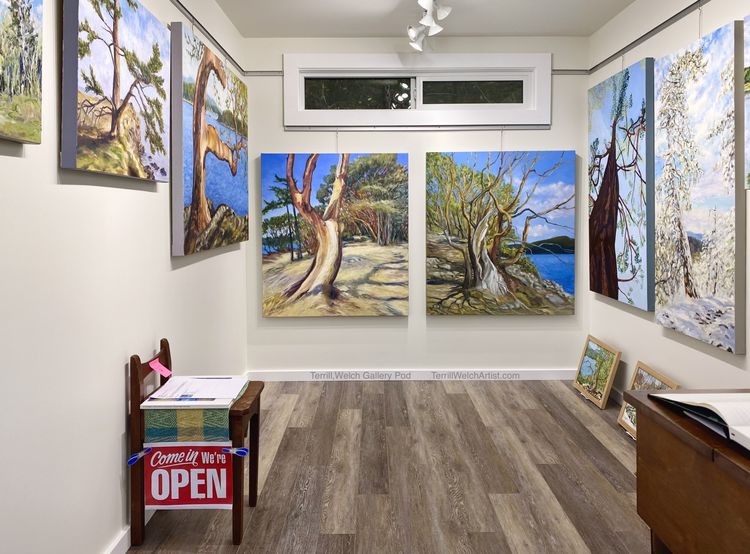
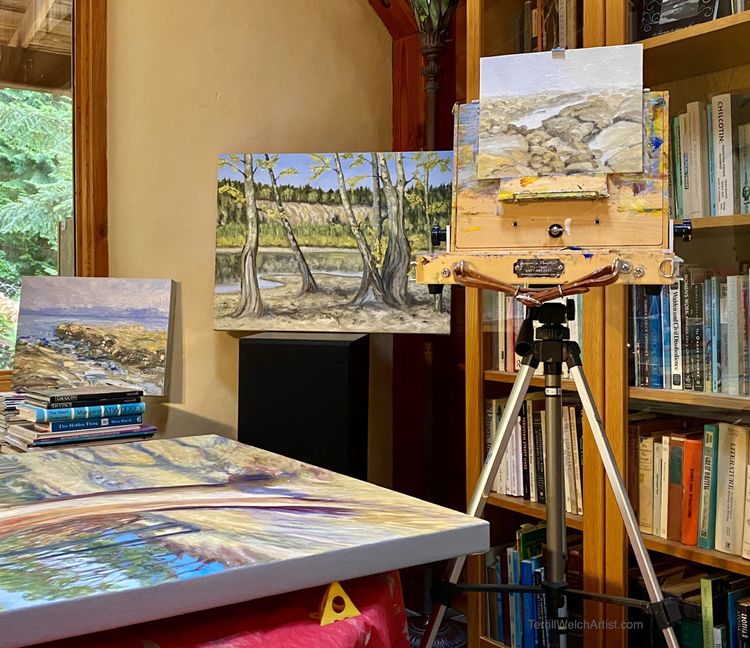
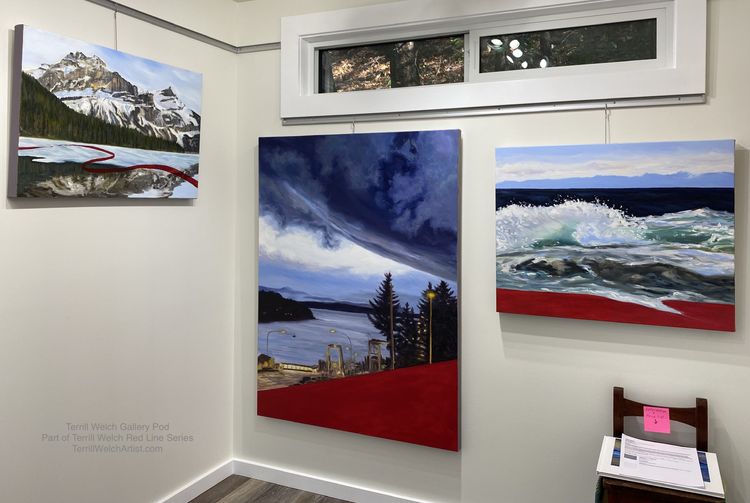
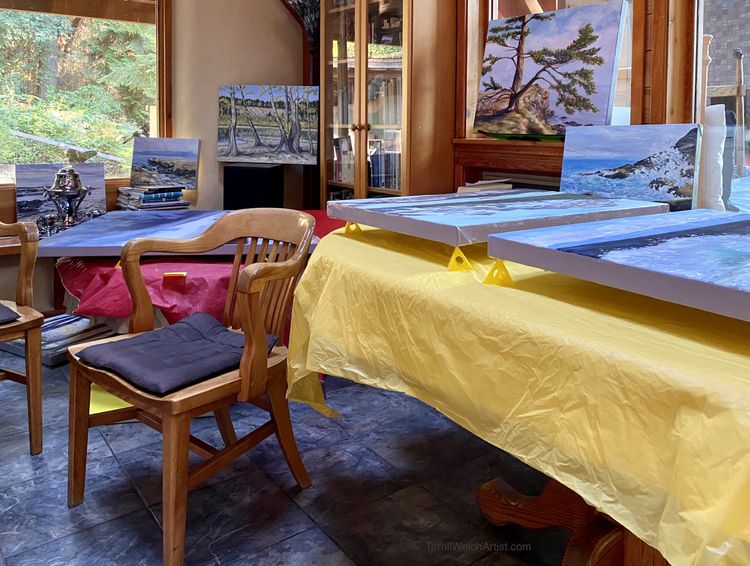
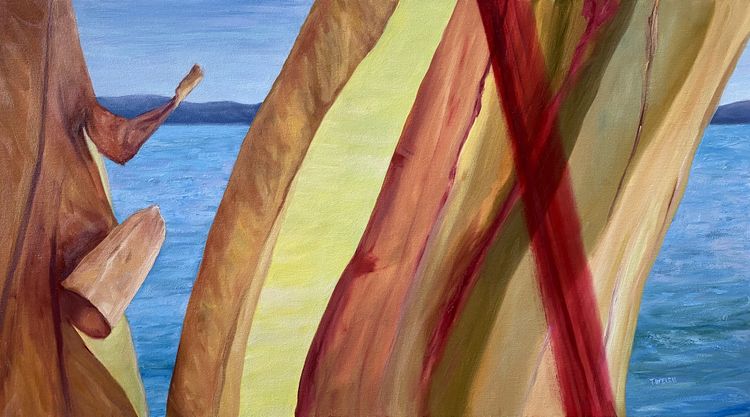
Member discussion